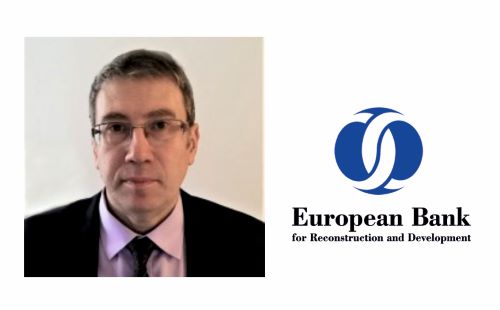The fall of the Berlin Wall in 1989 was one of the monumental events, which led to the EBRD’s creation. The European Bank for Reconstruction and Development (EBRD) was established to facilitate transition of the former communist countries in central and Eastern Europe to a free, market-based, competitive and green economy, and to help the region integrate into the new, post-Cold War reality.
The Bank has since played a historic role and gained unique expertise, investing more than €145 billion in more than 5,700 projects in nearly 40 countries from central Europe to central Asia and the southern and eastern Mediterranean. Safeguarding the environment and a commitment to sustainable energy have also always been central to the EBRD’s activity. More recently, the Green Economy Transition approach has made climate finance a key measure of the Bank’s performance.
Alexander Hadzhiivanov, Green Economy Specialist, Environmental and Sustainability Department of the EBRD explains the Bank’s approach to green and potential links with the ALDREN project.
- The EBRD has signed €34 billion in green investments. To define what is “green” and eligible for green funding, EBRD has created the Green Economy Transition (GET) handbook. What are the key points of the definition of green in the GET handbook related to building developments?
The EBRD GET Handbook reflects general provisions of the Multinational Development Banks (MDBs) Climate Finance Methodology. The latter provides a set of general definitions and guidelines as well as a list of eligible activities that allow identifying, tracking and consistent accounting and reporting of financial flows identified as climate finance. The Joint MDB Methodology has being developed by the Joint Climate Finance Tracking Group of Multilateral Development Banks (MDBs)* based on their experience and knowledge of climate activities and available best practice low-carbon technologies. It is still a work in progress, being further refined and amended with the aim of providing a higher- level methodological guidance in the area of climate finance. These higher-level principles are further defined by each individual MDB into own operational policies, requirements and processes, in order to reflect specific characteristics of the markets in which the given MDB operates. The EBRD GET Handbook converts the general principles of the Joint MDB Climate Finance Methodology into practical and operational policies to be applied by the Bank. The following main criteria are at the core of the EBRD GET Handbook:
– Supporting activities that advance the transition to an environmentally sustainable, low-carbon and climate-resilient economy
– Preventing economies from being locked into carbon-intensive, climate-vulnerable and/or environmentally damaging pathways
– Enhancing innovation
– Broadening the environmental dimensions of investment, from projects in sustainable energy and resource (water and materials) efficiency to all other types of projects that result in net physical environmental benefits
– Mobilising and scaling-up the use of private and public financing channels.
- What are the financial advantages for a building owner to be GET eligible? Do the advantages only apply to the loan or does GET also recognise a higher asset value of green buildings?
Advantages of making an asset GET-compliant means that for the owner:
– The building is energy and resource efficient, with lower operation costs, including but not limited to lower utility bills
– The building will use state of the art, reliable, and environmentally friendly technologies, which will ensure better quality of the environment, and potentially higher productivity of activities conducted in such building
– Lower regulatory and compliance risks related to any future amendments of technical and environmental regulations
– Potentially easier access for funding and better financing terms due to lower risks as described above
– Potentially higher asset value and better position on the market in the future, taking into account that current market development more and deeper reflects environmental liabilities associated with any economic activities and investments.
We do not yet fully reflect all of these advantages in our credit and risk assessment models. However, we do follow external expert discussions and policy development across the EU and will incorporate them soon into our standard financing models.
- In Annex 5.2 of the GET finance for building developments, activities are eligible for GET if they reach LEED-Silver or BREEAM-GOOD. Do you think that the ALDREN certification, which is based on applicable EU standards, could also satisfy the eligible criteria of GET, and if yes what is the procedure that ALDREN is officially recognised by EBRD?
Actually, we are in the process of amending our requirements for GET eligible investments in buildings in order to reflect the introduction of the EU NZEB requirements as well as the provisions of the EU Taxonomy. We do further accept credible international certification schemes above a certain threshold (i.e. BREEAM Very Good, LEED-Gold, DGNB-Silver, the new net zero carbon version of the EDGE, etc) and in general by any other certification method with a sufficient level of ambition, using credible and comprehensive methodology and operated with integrity. We do believe ALDREN is a much needed, practical model, which meets all of our formal criteria. For these reasons, we would be very happy to consider ALDREN as GET eligible in the upcoming amended version of the EBRD GET Handbook.
(*) The MDBs involved are African Development Bank; the Asian Development Bank; the Asian Infrastructure Investment Bank; the European Bank for Reconstruction and Development; the European Investment Bank; the Inter-American Development Bank Group; the Islamic Development Bank; and the International Bank for Reconstruction and Development, International Development Association, International Finance Corporation, and Multilateral Investment of the World Bank Group
This interview is part of the “REHVA Journal” 03/2020 (August 2020). More information HERE


Recent Comments